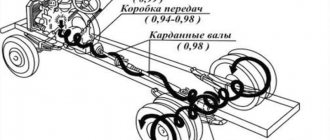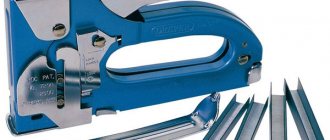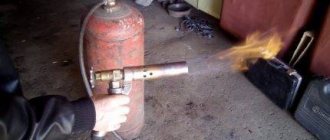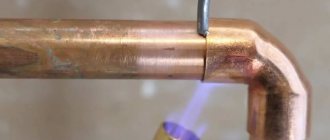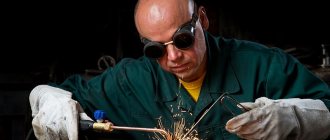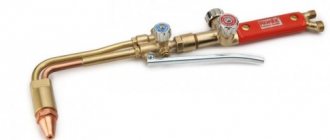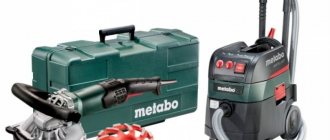Gas burners for a cartridge with a collet connection represent a separate class of tools. They are used in conditions of high fire safety where serious construction equipment is involved, and the risk of damage to the apparatus is minimized.
The main parameters are temperature and flame shape. In the simplest devices, the combustion temperature is close to the minimum - 700−1000°C. Air comes naturally and there is never enough of it. More expensive products have a special shape of air supply channels, which increases air flow and the flame temperature increases to 1200°C.
The flame has an even higher temperature in ejector burners, in which air is supplied to the hearth due to rarefaction, and the flow force is directly proportional to the operating gas pressure. Thanks to this, the temperature can be increased to 1500−1600°C and relatively smoothly adjusted with the flame length just by turning the tap. There may be several sources of combustion in the apparatus. This tool does not perform delicate work, but it successfully heats large areas.
The threshold temperature of the burners is 2000−2400°C, and it is achieved by concentrating the injected air into the combustion chamber, as well as using methyl acetylene propadiene gas (MAPP). A high-temperature cone is formed in the flame, whose power and temperature can be compared with oxy-fuel welding.
In addition, any type of product can be equipped with a flexible or rotary tube, piezo ignition and a highly sensitive control valve. There is a wide selection of devices based on power and gas consumption .
Gas-burner. Types and work. Application and features
A gas burner makes it possible to obtain a controlled flame to perform various tasks. It is widely used in everyday life for welding, soldering, repair and household work, as well as cooking in camp conditions.
Where is a gas burner used?
This equipment is suitable for the following tasks:
- Softening plastic elements to give them the desired shape.
- Bending PVC pipes.
- Melting of non-ferrous metals.
- Warming up welds.
- Calcination of workpieces.
- Thawing ice in the pipeline.
- Disinsection of wooden structures.
- Quick ignition of the hearth.
- Scorching animal carcasses.
Gas burners produce a controlled flame with an even flame, the power of which can be easily adjusted using the existing valve. Thanks to this, the actual heating temperature can change depending on the required material that is heated or fired. Such a device is useful to have in almost any house or apartment. Even if there is no need to use it as a tool for soldering or welding, the burner will be useful for basic, easy lighting of a fire at a picnic. Its use is much more economical than using a special liquid for igniting the barbecue. Gas burners are used by beekeepers to disinfect wooden hives. Animal cages are also treated with flame, which is much safer and cheaper than using chemicals.
Burner ignition methods
Burners can be ignited by using a lit match, a lighter, or by pointing at an open flame source. This option is trouble-free and is found on devices in the lower price segment. A little more expensive, but also more convenient, is the presence of piezo ignition. The design of such devices includes a piezoelectric element that is activated when a button is pressed. It produces a spark that can ignite a gas jet. The operating principle of the device is similar to an ordinary push-button lighter. Often the piezo ignition resource is lower than the burner itself. When you leave it standing, you can then use ordinary matches or a lighter. Piezo ignition is an expansion option that does not affect the performance of the burner in any way.
Types of mini burners
A gas burner is a very popular device, so many manufacturers are working to improve this design for specific tasks that can be performed with its help.
Now you can find the following types of this equipment:
- Tourist burner.
- Cutter.
- Blowtorch.
- Gas soldering iron.
Tourist burner
Gas burners for tourism or camping have recently become very popular. They are connected to a miniature gas cylinder. You can use them to prepare food or heat water for tea and coffee. This is much more convenient than using a regular hearth. The burner does not emit smoke or unpleasant odors. As a result of combustion, only carbon monoxide is formed in small quantities.
Tourist burners come in three types with:
- Installation on a cylinder.
- Lateral connection of the cylinder.
- Long hose.
A gas burner mounted on a cylinder is the most common. It is a compact and trouble-free design. However, it is not without its shortcomings. Often its burner is very small, which is due to design features. This is due to the fact that creating a large flame source will lead to critical heating of the cylinder itself, which can lead to an explosion. When using such a burner, it is prohibited to install wind shields close to the flame. To light a burner in windy weather, you need to find a secluded place. The stability of this design depends on the width of the cylinder. Considering that compact kitchen utensils are used in camping conditions, the volume of which rarely exceeds 2 liters, the risk of tipping over is minimal. However, the burner must be carefully monitored, since it does not go out if it falls on its side. If the flame stops burning in windy weather, the gas will continue to escape until it runs out.
Burners with a side cylinder connection are the cheapest. This is not the best option, but it has its advantages. First of all, this is the compactness of the can itself. Its dimensions are identical to hairspray, which is quite small. If you plan to cook food one or more times, then using just such a burner on a camping trip would be a very wise decision. The positive side of the design is its high resistance to tipping towards the cylinder, which allows it to be installed even in conditions of a slight inclination.
A gas burner with a long hose is the best option. This design is less impact-resistant than the previous ones, since it has more delicate elements. At the same time, thanks to the presence of a hose, you can install the cylinder further from the burner. This will allow you to use a windscreen moved closer to the flame. Thanks to this, it will be possible to retain heat in one place, which will significantly increase the speed of boiling water or heating food, while reducing the amount of fuel burned. When using such a burner, you must be careful with the hose to prevent it from breaking. For such devices, temperature control is carried out on a reducer, which is fixed on the cylinder.
Cutters
The gas burner cutter is pistol type or so-called L-shaped. The device is directly fixed to the can and creates a narrow flame. Of course, the actual combustion power does not allow the device to be used as a real cutter capable of cutting ferrous metal. The burner's capabilities allow you to burn through an aluminum tin can. These are inexpensive devices that can be used as an effective flame starting tool. With their help, it will be possible to heat plastic pipes at the point where they are bent, as well as heat the tip of a large soldering iron with solder.
All cutters that can be found on sale have piezo ignition. The combustion temperature of their flame is quite high, and due to the fact that the torch is narrow, the required point on the workpiece is heated with minimal dispersion of the fire, which saves fuel.
Operation and Safety
Work using gas and open fire is associated with the risk of a fire hazard, therefore, when working with them, safety regulations must be followed.
Basic requirements of the rules:
- Before starting work, the user must carefully study the technical documentation for the burner provided by the manufacturer.
- It is not allowed to overheat the cylinder due to the close distance to thermal sources or leave the device under the sun. It can rupture and injure others with its sharp edges.
- Cylinders are filled to no more than 80.0% of the full volume in order to provide a buffer during compression to prevent water hammer.
- The filling volume is controlled by weighing, according to the manufacturer’s conditions.
- It is not recommended to store empty containers for more than 30 days. Their design is designed to work under pressure; in the absence of it, the design of the seat is damaged, and after filling with gas, leaks will occur. In this case, you cannot empty the cylinder completely; you must always leave a small amount of gas.
- It is not recommended to throw away the plastic plugs upon purchase; after working with the device, they must be put back in place, otherwise sand or other debris will quickly clog the valve. If it is still lost, cover the neck of the cylinder with a piece of rubber.
- It is not allowed to bleed the cylinder with a nail. It is necessary to treat rust on the body of the cylinder, even with nail polish. The device body is made of thin metal sheet up to 0.4 mm. Violation of the integrity of the coating leads to the development of corrosion processes that quickly damage the vessel. Especially in the area of the bottom and rolling, since they are in the critical load zone of about 16 kgf/cm2
The mini gas burner is a successful invention of our time, capable of creating a controlled, even, high-temperature flame for different heat treatment modes, which makes them indispensable assistants in almost any home
How to light it?
Special literature usually indicates a clear procedure for igniting the device. First of all, oxygen access is opened. Then the combustion gas is supplied. The resulting mixture must be ignited immediately. Extinguishing is carried out in the opposite order: first the gas valve is closed, then the tap responsible for the oxygen supply is closed.
But using a gas burner according to this scheme makes sense mainly when working with acetylene. This is important because otherwise an unpleasant effect occurs - a “backlash” of the flame.
The problem is that if you turn on the oxygen first and then the gas, the flame is likely to be blown out by the oxygen flow. Therefore, the feed should not be opened completely, but by ¼. Some solve the problem differently: they initially open the gas, ignite it and gradually open the access of oxygen. This method helps to adjust the torch, and the only drawback is a small amount of soot.
To come in
Already registered? Sign in here.
There are currently 0 users on the page
There are no users viewing this page.
When repairing roofing coverings, it is often necessary to use hot air and even fire: to melt bitumen, melt the underside of roofing felt, and even solder the edge of a metal sheet. And for this you already need special tools. But why not just set the same roofing felt on fire with a homemade torch if our goal is to melt the bitumen?
Tips for choosing the best burner
People buy compact hand burners with pleasure, as they have many advantages over liquid fuel, more “serious” devices. They light quickly, hardly get dirty, and require a minimum of care.
Criterion #1 – scope of use of the device
First of all, you should determine exactly what the gas appliance will be used for, since burners for soldering and for heating food are radically different in both design and parameters.
Construction tools often resemble a gun in shape. When working, it is convenient to hold them with one hand, and with the other at this time you can support the part or bring solder.
Criterion #2 – technical characteristics of the model
Characteristics such as weight and size are important if the burner has to be taken on hikes or often used at home. A heavy tool causes rapid fatigue, while a light one is much more comfortable to work with.
We pay attention to such characteristics as:
- flame temperature – from 480 to 2500°C;
- heating temperature – from 550 to 2500°C;
- power – 0.5-3 kW;
- the ability to connect cans with different fuels;
- method of connecting the cartridge to the burner;
- flame type, torch shape;
- fuel consumption – from 60 to 1000 g/h;
- weight – from 50 grams to 1.7 kg.
If you are purchasing a torch specifically for soldering copper pipes, then a low-temperature model will do.
To cut or weld steel parts, you will need a more powerful machine, usually called a torch or welding torch.
High temperature gas burners
We cannot ignore burners that use MAPP gas instead of a propane-butane mixture. The flame combustion temperature in them is 2200–2400 °C, while the main energy is concentrated in a cone, which is quite stable and has a pronounced boundary.
Such burners are used for heating, forging and bending high-carbon steels and massive parts. High temperatures also allow for better quenching and tempering of metal.
In terms of soldering and welding, MAPP gas torches do an excellent job with stainless steel, and even thin parts do not overheat. Another advantage of MAPP gas is its low boiling point, which makes it possible to use it at temperatures as low as -20 °C even in burners without a heating circuit.
High temperature gas burners
These models use MAPP gas, and the combustion temperature reaches 2200 – 2400°C. They are used for forging and bending high-alloy steel alloys and massive workpieces. With such high temperatures, high temperature gas torches are great for hardening and tempering metals. An additional advantage of MAPP gas is its low boiling point, thanks to which these devices work perfectly even at temperatures as low as -20°C.
Indicators related to the flame of the device
gas burner flame
The burner flame power can be low (fuel consumption is 25-400 dm3/h), medium (400-2800 dm3/h) and high (2800-7000 dm3/h). Knowing the maximum and minimum power of a particular burner, you can calculate the fuel consumption and the amount of energy required to meet technological needs.
According to the number of flames, burners are single-flame and multi-flame. If the first type is used primarily for manual oxygen-acetylene welding, the second is widely used for mechanized flame soldering or heating.
Where are gas soldering irons used?
This tool is designed for soldering and fusing small parts - wires, circuit boards, contacts, etc. It is especially needed where there is no electricity, so this soldering iron has gained great popularity among builders, installers and electricians who work on sites under construction, among those who, as part of their duties, often have to solder wires and cables on the roof, in basements, etc. d. The advantages of a gas tool will also be appreciated by home craftsmen, because even at home it often happens that the soldering point is located so inconveniently that crawling up to it with a bulky electric soldering iron and a wire is a whole adventure. Gas soldering irons will eliminate such inconveniences.
Here are some examples of using this tool:
- for soldering a copper car radiator - the desired section of the radiator is heated until the tin becomes liquid and then it needs to be leveled by adding tin wire.
- for heating heavily rusted fasteners (bolts, nuts, etc.)
- for soldering when repairing equipment and electrical devices. If there is no electricity in the garage, then a gas soldering iron in this case is the only way out.
And for lovers of hiking and picnics, it would be a good idea to learn about such a variety of gas tools as burners, with which you can quickly heat up food without long attempts to make a fire from damp wood.
Restrictions on use
When dealing with gas-powered hand tools, the following rules and precautions must be observed:
- Do not use the tool in a poorly ventilated area, near flammable or explosive substances;
- You should always work in a stable position so that in case of unforeseen situations, you can fully control the tool.
- let the tool cool down before changing tips - these soldering iron elements can also heat up to 500? C.
Remember! Before working with a gas soldering iron, be sure to read the instruction manual.
Functional types of gas burners and their characteristics
Mini-torches with a collet connection belong to a special group of fireproof tools when performing complex construction work and expensive equipment, where the risk of damage should be minimized.
The main parameters of this type of burner are the temperature of the working area and the geometric dimensions of the flame. For cheap devices, the temperature is equal to a low threshold - 800-1000C. Since air comes in through natural suction, there is never enough air for complete combustion. Therefore, more expensive devices have a perfect air supply system using special channels that increase the volume of air and, accordingly, increase temperatures up to 1200C.
Ejector burners with air suction, due to vacuum, develop a flame with a higher T to 1400-1600 C, and the air volume is proportional to the gas pressure. Thanks to this principle, a system for adjusting T and torch dimensions using a control valve was built.
The maximum threshold welding temperature is 2000−2400C, achieved by concentrating air in the burning zone, as well as using MAPP gas to form a gas-air high-temperature cone, whose parameters are comparable to a stationary gas welding station.
Soldering torch on a can
Supercharged blowtorches
These lamps have a special device, which makes them the main tool for specialists working with non-ferrous metals. High-temperature mode with adjustable torch parameters are suitable for high-quality soldering or other heat treatment, with high-precision modes for temperatures and torch geometry.
The specifics of the unit affects the size of the structure and nozzles. Small ones are used for jewelry work. Middle-class devices with a cone thickness from 4.0 to 9.0 mm are used for electrical soldering of cable lines of electrical networks, copper pipes in heat and water supply systems.
Powerful large burners are used for artistic forging, precision bending and stamping work. They are the basis of a system of homemade furnaces and forges.
Tourist burner with spray can
Tourist burners
These modifications belong to the low-temperature class, have a wide range of purposes and are used both for the housing sector and for installation and construction work. They usually replace electric hair dryers in areas where there is no electricity.
The main disadvantage of these devices is the lack of injectors and, as a result, low quality of the flame, which manifests itself when the work is tilted due to the natural splashing of the filled fuel. This effect does not manifest itself in expensive devices equipped with a gearbox and a heating system.
Due to their shortcomings, such torches are not used for soldering. Their area of application is ignition of solid fuel or heating of materials using an open torch. The indispensability of such a tool has been demonstrated in work on thawing pipeline systems, heating car engines, removing paint and other preparatory work.
Burner cutter
High temperature models
This type of burner, instead of propane-butane, is filled with MAPP gas with a cone combustion temperature of up to 2400 C. The cone in such devices has a clearly defined boundary. The devices are expensive and are used for high-precision work for forging and bending large parts made of high-carbon steels.
A positive feature of MAPP gas is the ability to process stainless steel components without deforming even the most elegant components. Another important advantage of the model is the low boiling temperature of the gas filler, so it can be used for work at T -20 C, including in devices not equipped with a heating circuit.
Varieties
Based on configuration, the best gas burners are divided into several categories:
- "Pencil". The variety is the most compact of all versions, has a cylinder-shaped body, and is suitable for performing high-precision manipulations.
- Blowtorches. The handle of such modifications is placed perpendicular to the nozzle, under which there is a housing with a cartridge.
- Mini soldering iron. The design is similar to a “pencil”, but differs in better execution. The system includes replaceable nozzles, smooth adjustment of the fuel supply, and a folding locking leg.
- Burner attachment for a spray can. Such modifications are low cost and include a housing, an atmospheric damper, a fuel supply corrector, a nozzle, and piezo ignition. These devices are manufactured in different variations.
- Pistol accessories. The configuration of the models is L-shaped, which facilitates fixed fixation on the stand in the right place. Thanks to this, a person can perform operations with both hands.
- Tourist gas burner. It is placed directly on the cylinder and is filled using a hose and a side cartridge.
Each of these configurations has its own disadvantages and advantages; before choosing a model, you should look at its review and read the reviews. Some versions are designed for processing heat shrinks, heating metal, plastic, bolts, nuts. Other modifications are adapted for cooking and lighting a barbecue. Some options have good stability, increased flame temperature, and compact dimensions. Which canister gas burner with piezo ignition is better depends on its purpose and additional functions.
"Pencil"
Pistol
Mini soldering iron
Tourist
Burner attachment
Blowtorch
By area of use
An open flame is required both during installation work and at home or on vacation. A camping burner allows you to quickly build a fire and heat up food. The design of such equipment is not equipped with a nozzle barrel. Instead, there is a long thin hose that serves to supply the fuel mixture to the outlet.
Main selection criteria
Experienced buyers advise when choosing a gas burner to consider the following parameters:
- – The main thing is to decide on the purpose of purchasing the burner. To perform construction work and simple household needs, different models are needed.
- – For construction work, it is best to choose a gun-shaped torch. It will be convenient to hold it in one hand, while the other can be used to support the material with which you are working.
- – Manufacturers offer compact models for hiking and trips to the country. They can easily fit in a backpack or car glove compartment.
- – Models with a low melting point are suitable for soldering pipes.
- – One of the main parameters is gas consumption. This will allow you to calculate how long one replacement cylinder will last.
DIY repair
Like any other tool, a gas burner can fail over time. This problem can be caused by the following reasons:
- nozzle clogged with debris;
- divider clogged with dirt;
- melting of parts;
- hose damage;
- damage to gaskets;
- mechanical deformation.
Before you start repairing your device, you should prepare some tools:
- equipment for dismantling burner parts;
- a thin needle or wire necessary to clean the nozzle;
- a towel or film for covering the surface.
To learn how to properly use a gas burner, watch the following video.
Rating of the best gas burners for a can
From all the variety, we can highlight the following models, which are most popular among buyers:
Rexant GT-19
Compact gas burner with adjustable flame level. Butane, propane and isobutane can be used as fuel. Fuel consumption – 80 g/h. Suitable for quickly heating surfaces. The maximum flame temperature is 1400 degrees Celsius. Price in stores – from 500 rubles.
- conveniently attaches to the cylinder with a click
- lights up the first time
- burns steadily
- There is a ignition button, the piece works properly
- sits tightly on the cylinder
- the gas is regulated very sharply, you need to turn the flame adjustment knob very smoothly
Energy GTI-100
A high-power gas burner that can be used as a blowtorch. The main advantages are ease of use and compact size. Flame temperature – 1300 degrees Celsius. Another advantage is efficiency. Fuel consumption is only 80 g/h. Price – from 600 rubles.
- steady flame
- economical gas consumption
- presence of piezo ignition
- securely connects to the cylinder
- all plastic parts are located far from the heating point (they will not melt)
- when working with an inclination, preheating of the burner is necessary, otherwise the flame will be unstable
DAYREX DR-45
A convenient burner that ensures safe use due to a safety system that protects connections from fuel leaks. The burner head can rotate 360 degrees without changing the flame intensity. Price in stores – from 700 rubles.
- made carefully, assembled tightly
- reliable security system
- economical gas consumption
- high power rating
- detailed instructions in Russian
- not detected
Flame Gun
A burner designed for tourist purposes due to its low gas consumption and compact size. Can also be used when working with metal products. It will be useful for motorists when unscrewing acidified bolts and removing old paint from surfaces. Prices in stores start from 400 rubles.
- excellent quality
- multifunctionality
- produces a steady, even flame
- easy to turn on and off
- the flame is easily regulated by the valve
- not detected
Sturm 5015-KL-02
A household gas burner with flame protection from wind, which will be especially useful when lighting fires or barbecues. Fuel consumption is slightly higher than that of previously presented models and is 86 g/hour. Isobutane, propane and butane are used as fuel. Prices in stores start from 550 rubles.
- using the wheel you can adjust the flame power
- ignition is carried out using a piezo element
- burns steadily when turning in different directions after 2 minutes. warming up
- lights up the first time
- fits tightly onto the bottle
- according to some customers' reviews, it quickly breaks down
STAYER 55584 MASTER
A small gas burner weighing only 150 grams. There is a function for adjusting the flame strength, the maximum temperature is up to 1300 degrees. Propane or butane is used as fuel. Price in stores – from 400 rubles.
- reliable assembly
- multifunctionality
- convenient flame control system
- reliable fastening
- Piezo ignition works flawlessly
- not detected
STAYER 55584 MASTER
Kemper Emper 1064 E
A torch used for installation construction work, as well as for soldering copper products. The flame strength can be adjusted, as well as its fixation. The set includes two nozzles. To operate the burner you will need a threaded container. Price in stores – from 2,000 rubles.
- durability
- light weight
- economical gas consumption
- 2 working attachments
- preheating function
vote
Article rating
What gas is used in cylinders
Almost all cylinders contain a mixture of propane with butane or isobutane in different proportions. An important selection criterion is the amount of propane:
- The vast majority of cylinders contain 20-30 percent propane. Such products are quite suitable for use with burners, however, when the temperature drops to -15 degrees, the gas simply will not burn.
- 50 percent. With such a propane content, the cylinder can easily be used in winter, withstanding temperatures down to minus 30. This is confirmed by the snowflake on the surface of the product.
- 100 percent. Coleman produces pure propane in cylinders. The gas burns well at temperatures down to -42 degrees Celsius. In this case, thick-walled cylinders are used, which prevents their destruction in severe frost.
Propane is not used at all in the products of domestic companies. Such cylinders contain 100 percent butane, isobutane or a mixture of these gases. The products work great in the summer, but fail even at minus 5 degrees.
When choosing between butane and isobutane, try to buy the second option. It burns more stably, which is explained by the high octane number and uniform composition. How long does a bottle last? The answer to this question depends on several important factors:
- Terms of Use. During the cold period, the cylinder stops working much faster than in summer.
- Volume. If you give exact figures, then a 500 gram can can burn for about two days.
- Intensity of use. The continuous burning time of a 0.5 liter cylinder is 5-6 hours. But if you only cook food 3-4 times a day, you will get the 2 days mentioned above.
Almost any canister (except a pierceable one) can be recharged. How to do it? It is best to contact specialized companies, since refueling yourself can lead to unpredictable consequences. After recharging, do not risk taking the product on a camping trip. It is suitable for household purposes only.
